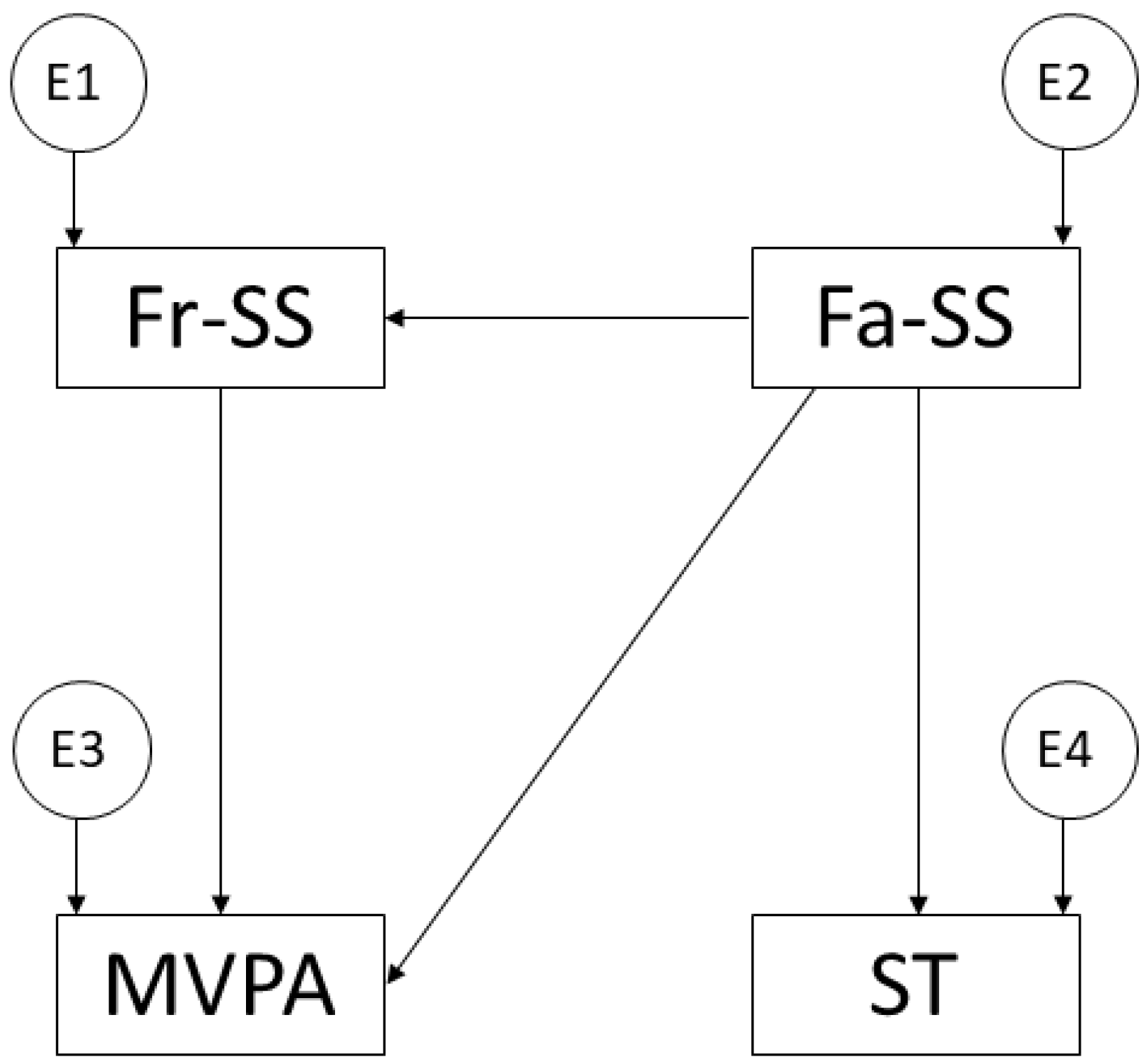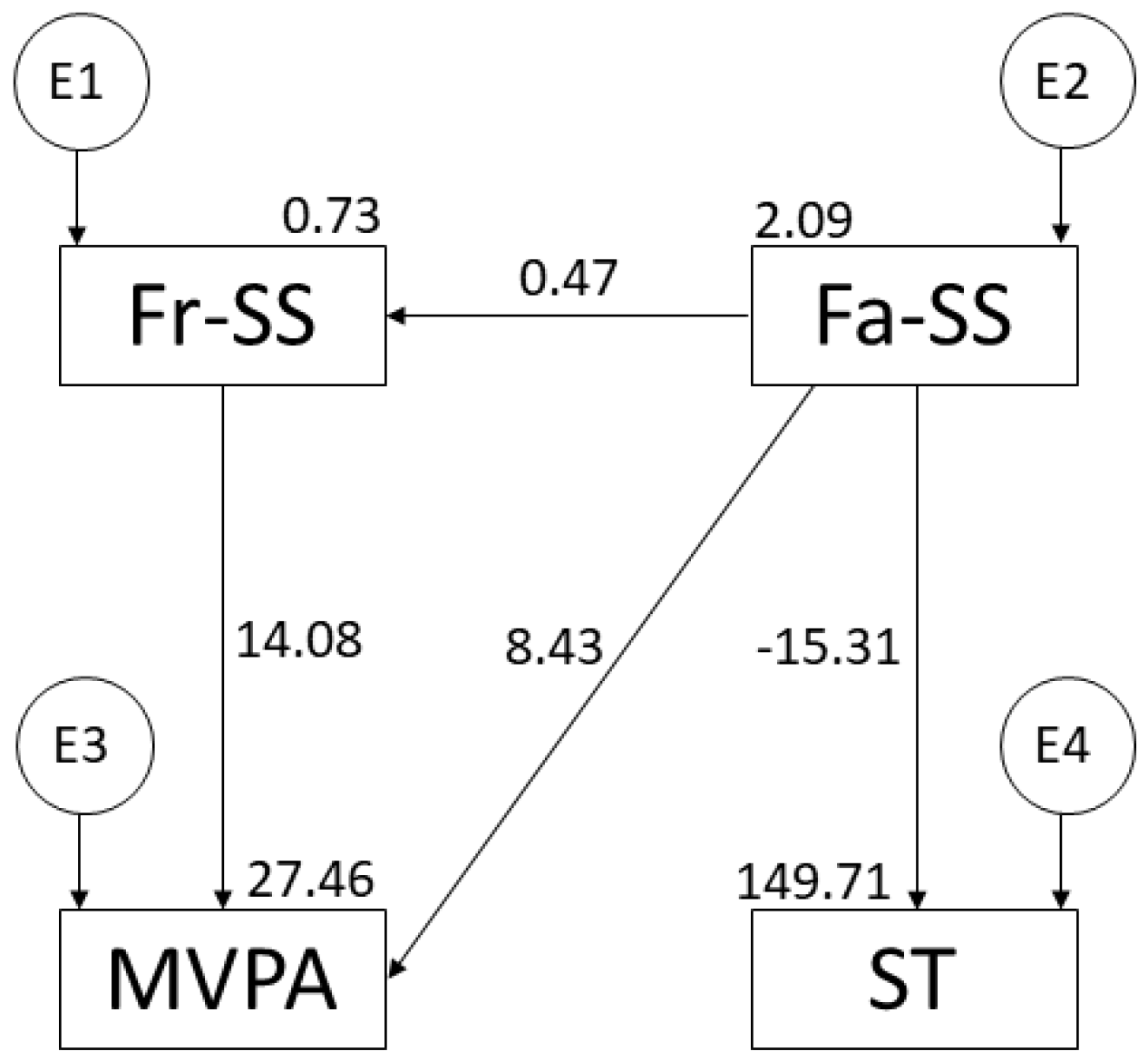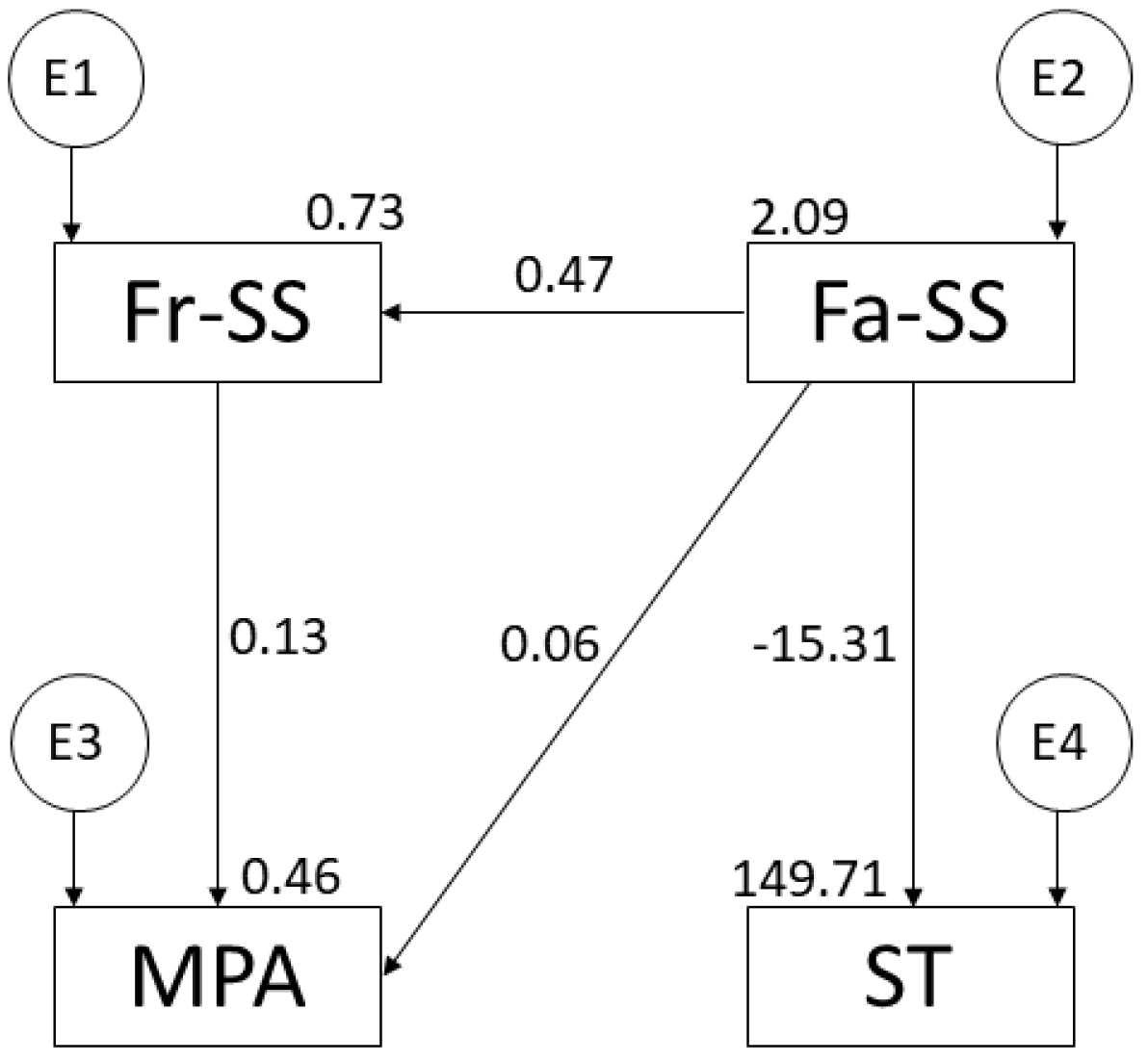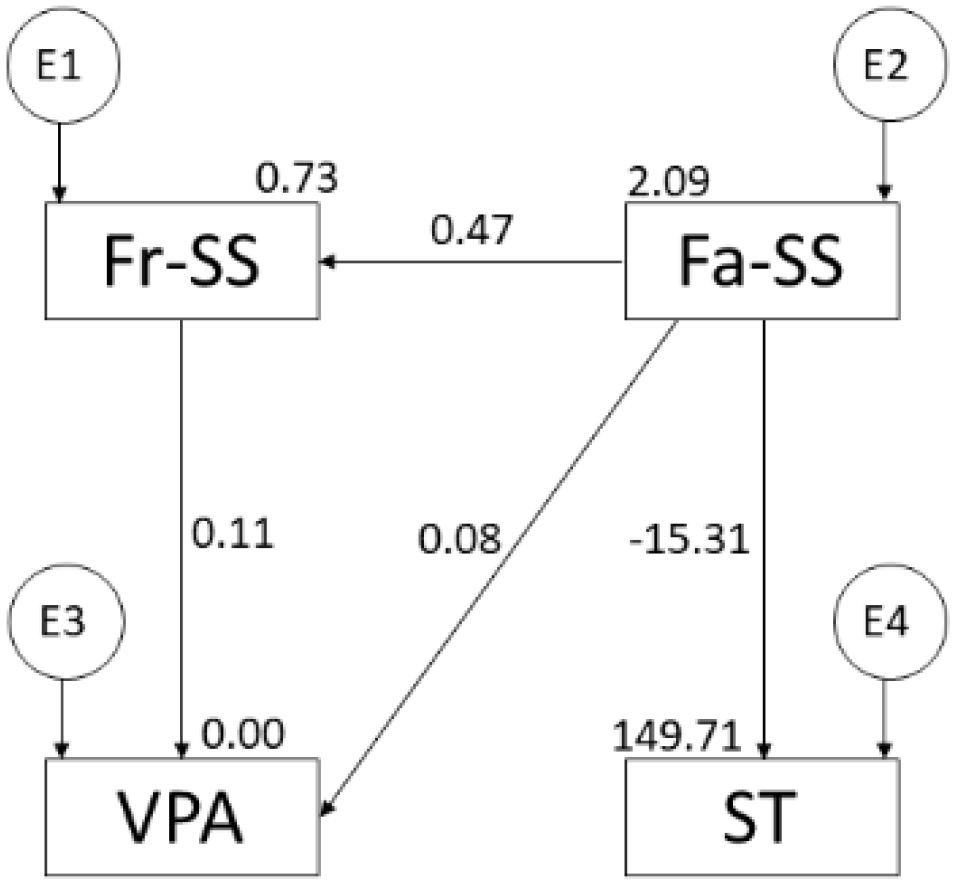Moderate-Vigorous Physical Activity, Family Support, Peer Support, and Screen Time: An Explanatory Model
Abstract
1. Introduction
2. Materials and Methods
2.1. Design and Subjects
2.2. Instruments and Variables
2.3. Procedure
2.4. Data Analysis
3. Results
4. Discussion
5. Conclusions
Author Contributions
Funding
Institutional Review Board Statement
Informed Consent Statement
Data Availability Statement
Acknowledgments
Conflicts of Interest
References
- Poitras, V.J.; Gray, C.E.; Borghese, M.M.; Carson, V.; Chaput, J.P.; Janssen, I.; Katzmarzyk, P.T.; Pate, R.R.; Gorber., S.C.; Kho, M.E.; et al. Systematic review of the relationships between objectively measured physical activity and health indicators in school-aged children and youth. Appl. Physiol. Nutr. Metab. 2016, 41, S197–S239. [Google Scholar] [CrossRef] [PubMed]
- Rodriguez-Ayllon, M.; Cadenas-Sánchez, C.; Estévez-López, F.; Muñoz, N.E.; Mora-Gonzalez, J.; Migueles, J.H.; Molina-García, P.; Henriksson, H.; Mena-Molina, A.; Martínez-Vizcaíno, V.; et al. Role of Physical Activity and Sedentary Behavior in the Mental Health of Preschoolers, Children and Adolescents: A Systematic Review and Meta-Analysis. Sports Med. 2019, 49, 1383–1410. [Google Scholar] [CrossRef] [PubMed]
- Strong, W.B.; Malina, R.M.; Blimkie, C.J.; Daniels, S.R.; Dishman, R.K.; Gutin, B.; Hergenroeder, A.C.; Must, A.; Nixon, P.A.; Pivarnik, J.M.; et al. Evidence based physical activity for school-age youth. J. Pediatr. 2005, 146, 732–737. [Google Scholar] [CrossRef] [PubMed]
- World Health Organization (WHO). WHO Guidelines on Physical Activity and Sedentary Behaviour; World Health Organization: Geneva, Switzerland, 2020.
- Kandola, A.; Lewis, G.; Osborn, D.P.J.; Stubbs, B.; Hayes, J.F. Depressive symptoms and objectively measured physical activity and sedentary behaviour throughout adolescence: A prospective cohort study. Lancet Psychiatry 2020, 7, 262–271. [Google Scholar] [CrossRef]
- Hoare, E.; Milton, K.; Foster, C.; Allender, S. The associations between sedentary behaviour and mental health among adolescents: A systematic review. Int. J. Behav. Nutr. Phys. Act. 2016, 13, 108. [Google Scholar] [CrossRef]
- Guthold, R.; Stevens, G.A.; Riley, L.M.; Bull, F.C. Global trends in insufficient physical activity among adolescents: A pooled analysis of 298 population-based surveys with 1.6 million participants. Lancet Child. Adolesc. Health 2020, 4, 23–35. [Google Scholar] [CrossRef]
- Steene-Johannessen, J.; Herman, B.; Eirik, K.; Kolle, E.; Northstone, K.; Christian, N.; Grøntved, A.; Wedderkopp, N.; Kriemler, S.; Page, A.S.; et al. Variations in accelerometry measured physical activity and sedentary time across Europe—Harmonized analyses of 47,497 children and adolescents. Int. J. Behav. Nutr. Phys. Act. 2020, 17, 38. [Google Scholar] [CrossRef]
- Serrano-Sanchez, J.A.; Martí-Trujillo, S.; Lera-Navarro, A.; Dorado-García, C.; González-Henríquez, J.J.; Sanchís-Moysi, J. Associations between screen time and physical activity among Spanish adolescents. PLoS ONE 2011, 6, e24453. [Google Scholar] [CrossRef]
- Robbins, L.B.; Ling, J.; Chang, M.W. Organized Physical Activity Program Participation, Physical Activity, and Related Psychosocial Factors Among Urban Adolescents. J. Sch. Nurs. 2021, 23, 10598405211038962. [Google Scholar] [CrossRef]
- Khan, S.R.; Uddin, R.; Mandic, S.; Khan, A. Parental and Peer Support are Associated with Physical Activity in Adolescents: Evidence from 74 Countries. Int. J. Environ. Res. Public Health 2020, 17, 4435. [Google Scholar] [CrossRef]
- Lawler, M.; Heary, C.; Shorter, G.; Nixon, E. Peer and parental processes predict distinct patterns of physical activity participation among adolescent girls and boys. Int. J. Sport Exerc. Psychol. 2021, 20, 497–514. [Google Scholar] [CrossRef]
- Lizandra, J.; Devís-Devís, J.; Valencia-Peris, A.; Tomás, J.M.; Peiró-Velert, C. Screen time and moderate-to-vigorous physical activity changes and displacement in adolescence: A prospective cohort study. Eur. J. Sport Sci. 2019, 19, 686–695. [Google Scholar] [CrossRef] [PubMed]
- Da Costa, B.G.G.; Chaput, J.P.; Lopes, M.V.V.; Malheiros, L.E.A.; Da Silva, I.C.M.; Silva, K.S. Association between screen time and accelerometer-measured 24-h movement behaviors in a sample of Brazilian adolescents. Public Health 2021, 195, 32–38. [Google Scholar] [CrossRef] [PubMed]
- Braig, S.; Genuneit, J.; Walter, V.; Brandt, S.; Wabitsch, M.; Goldbeck, L.; Brenner, H.; Rothenbacher, D. Screen Time, Physical Activity and Self-Esteem in Children: The Ulm Birth Cohort Study. Int. J. Environ. Res. Public Health 2018, 15, 1275. [Google Scholar] [CrossRef] [PubMed]
- Dahlgren, A.; Sjöblom, L.; Eke, H.; Bonn, S.E.; Lagerros, T.Y. Screen time and physical activity in children and adolescents aged 10-15 years. PLoS ONE 2021, 16, e0254255. [Google Scholar] [CrossRef]
- Noland, M.P.; Feldman, R.H.L. Factors related to the leisure exercise behavior of «returning» women college students. Health Educ. 1984, 15, 32–36. [Google Scholar] [CrossRef]
- Welk, G.J. The Youth Physical Activity Promotion Model: A Conceptual Bridge between Theory and Practice. Quest 1999, 51, 5–23. [Google Scholar] [CrossRef]
- National Statistics Institute. Government of Spain. 2022. Available online: https://www.ine.es/index.htm (accessed on 25 May 2022).
- Cale, L. Monitoring Physical Activity in Children. Ph.D. Dissertation, Loughborough University, Leicestershire, UK, 1993. [Google Scholar]
- Soler, J.J.; Generelo, E.; Zaragoza, J.; Julián, J.A. Validity and Reliability Criteria for the “Four by One-Day Physical Activity Questionnaire” in Spanish Adolescents. Apunt. Phys. Educ. Esports 2010, 101, 19–24. [Google Scholar]
- Peiró-Velert, C.; Valenciano, J.; Beltrán-Carrillo, V.; Devís-Devís, J. Variability of physical activity in 17-18 year-old Spanish adolescents by type of day and season. J. Sport Psychol. 2014, 23, 347–354. [Google Scholar]
- Beltrán-Carrillo, V.J.; Devís-Devís, J.; Peiró-Velert, C. Physical activity and sedentary behaviour in adolescents from valencian region. Rev. Int. Med. Cienc. Act. Fis. Deporte 2012, 12, 122–137. [Google Scholar]
- Prochaska, J.J.; Rodgers, M.W.; Sallis, J.F. Association of parent and peer support with adolescent physical activity. Res. Q. Exerc. Sport 2002, 73, 206–210. [Google Scholar] [CrossRef]
- Sanz-Martín, D. Levels of physical activity and perceived social support of adolescent students in the province of Soria. Ph.D. Dissertation, Complutense University of Madrid, Madrid, Spain, 2018. [Google Scholar]
- Sanz-Martín, D. Relationship between Physical Activity in Children and Perceived Support: A Case Studies. Apunt. Phys. Educ. Esports 2020, 139, 19–26. [Google Scholar] [CrossRef]
- Maydeu-Olivares, A. Assessing the Size of Model Misfit in Structural Equation Models. Psychometrika 2017, 82, 533–558. [Google Scholar] [CrossRef] [PubMed]
- McDonald, R.P.; Marsh, H.W. Choosing a multivariate model: Noncentrality and goodness of ft. Psychol. Bull. 1990, 107, 247–255. [Google Scholar] [CrossRef]
- Bentler, P.M. Comparative ft indexes in structural models. Psychol. Bull. 1990, 107, 238–246. [Google Scholar] [CrossRef]
- Kline, R.B. Principles and Practice of Structural Equation Modeling, 4th ed.; The Guilford Press: New York, NY, USA, 2016. [Google Scholar]
- Tenenbaum, G.; Eklund, R.C. Handbook of Sport Psychology; John Wiley & Sons: Hoboken, NJ, USA, 2007. [Google Scholar]
- Mendonça, G.; Cheng, L.A.; Mélo, E.N.; de Farias Júnior, J.C. Physical activity and social support in adolescents: A systematic review. Health Educ. Res. 2014, 29, 822–839. [Google Scholar] [CrossRef] [PubMed]
- Young, D.R.; Cohen, D.; Koebnick, C.; Mohan, Y.; Saksvig, B.I.; Sidell, M.; Wu, T. Longitudinal Associations of Physical Activity Among Females from Adolescence to Young Adulthood. J. Adolesc. Health 2018, 63, 466–473. [Google Scholar] [CrossRef]
- Morrissey, J.L.; Janz, K.F.; Letuchy, E.M.; Francis, S.L.; Levy, S.M. The effect of family and friend support on physical activity through adolescence: A longitudinal study. Int. J. Behav. Nutr. Phys. Act. 2015, 12, 103. [Google Scholar] [CrossRef] [PubMed]
- Haidar, A.; Ranjit, N.; Archer, N.; Hoelscher, D.M. Parental and peer social support is associated with healthier physical activity behaviors in adolescents: A cross-sectional analysis of Texas School Physical Activity and Nutrition (TX SPAN) data. BMC Public Health 2019, 19, 640. [Google Scholar] [CrossRef]
- Engels, E.S.; Nigg, C.R.; Reimers, A.K. Predictors of physical activity behavior change based on the current stage of change-an analysis of young people from Hawai’i. J. Behav. Med. 2022, 45, 38–49. [Google Scholar] [CrossRef]
- Costigan, S.A.; Barnett, L.; Plotnikoff, R.C.; Lubans, D.R. The health indicators associated with screen-based sedentary behavior among adolescent girls: A systematic review. J. Adolesc. Health 2013, 52, 382–392. [Google Scholar] [CrossRef] [PubMed]
- Park, S.H.; Park, H. Parental Support and Children’s Body Weight: Mediating Effects of Health Behaviors. West. J. Nurs. Res. 2020, 42, 718–727. [Google Scholar] [CrossRef] [PubMed]
- Jekauc, D.; Mnich, C.; Niessner, C.; Wunsch, K.; Nigg, C.R.; Krell-Roesch, J.; Woll, A. Testing the Weiss-Harter-Model: Physical Activity, Self-Esteem, Enjoyment, and Social Support in Children and Adolescents. Front. Psychol. 2019, 10, 2568. [Google Scholar] [CrossRef]
- Lisboa, T.; Silva, W.R.D.; Silva, D.A.S.; Felden, É.P.G.; Pelegrini, A.; Lopes, J.J.D.; Beltrame, T.S. Social support from family and friends for physical activity in adolescence: Analysis with structural equation modeling. Cad. Saude Publica 2021, 37, e00196819. [Google Scholar] [CrossRef] [PubMed]




| Variable Associations | R.W. | S.R.W. | ||||
|---|---|---|---|---|---|---|
| Estimations | S.E. | C.R. | p | Estimations | ||
| MVPA | Fr-SS ← Fa-SS | 0.474 | 0.022 | 21.932 | *** | 0.640 |
| MVPA ← Fr-SS | 14.077 | 3.658 | 3.848 | *** | 0.182 | |
| ST ← Fa-SS | −15.310 | 3.542 | −4.323 | *** | −0.162 | |
| MVPA ← Fa-SS | 8.428 | 2.709 | 3.112 | * | 0.147 | |
| MPA | Fr-SS ← Fa-SS | 0.474 | 0.022 | 21.932 | *** | 0.640 |
| MVPA ← Fr-SS | 0.127 | 0.054 | 2.336 | * | 0.114 | |
| ST ← Fa-SS | −15.310 | 3.542 | −4.323 | *** | −0.162 | |
| MPA ← Fa-SS | 0.058 | 0.040 | 1.441 | 0.070 | ||
| VPA | Fr-SS ← Fa-SS | 0.474 | 0.022 | 21.932 | *** | 0.640 |
| MVPA ← Fr-SS | 0.108 | 0.038 | 2.823 | ** | 0.135 | |
| ST ← Fa-SS | −15.310 | 3.542 | −4.323 | *** | −0.162 | |
| VPA ← Fa-SS | 0.082 | 0.028 | 2.919 | ** | 0.140 | |
Publisher’s Note: MDPI stays neutral with regard to jurisdictional claims in published maps and institutional affiliations. |
© 2022 by the authors. Licensee MDPI, Basel, Switzerland. This article is an open access article distributed under the terms and conditions of the Creative Commons Attribution (CC BY) license (https://creativecommons.org/licenses/by/4.0/).
Share and Cite
Sanz-Martín, D.; Ubago-Jiménez, J.L.; Ruiz-Tendero, G.; Zurita-Ortega, F. Moderate-Vigorous Physical Activity, Family Support, Peer Support, and Screen Time: An Explanatory Model. Int. J. Environ. Res. Public Health 2022, 19, 16177. https://doi.org/10.3390/ijerph192316177
Sanz-Martín D, Ubago-Jiménez JL, Ruiz-Tendero G, Zurita-Ortega F. Moderate-Vigorous Physical Activity, Family Support, Peer Support, and Screen Time: An Explanatory Model. International Journal of Environmental Research and Public Health. 2022; 19(23):16177. https://doi.org/10.3390/ijerph192316177
Chicago/Turabian StyleSanz-Martín, Daniel, José Luis Ubago-Jiménez, Germán Ruiz-Tendero, and Félix Zurita-Ortega. 2022. "Moderate-Vigorous Physical Activity, Family Support, Peer Support, and Screen Time: An Explanatory Model" International Journal of Environmental Research and Public Health 19, no. 23: 16177. https://doi.org/10.3390/ijerph192316177
APA StyleSanz-Martín, D., Ubago-Jiménez, J. L., Ruiz-Tendero, G., & Zurita-Ortega, F. (2022). Moderate-Vigorous Physical Activity, Family Support, Peer Support, and Screen Time: An Explanatory Model. International Journal of Environmental Research and Public Health, 19(23), 16177. https://doi.org/10.3390/ijerph192316177








